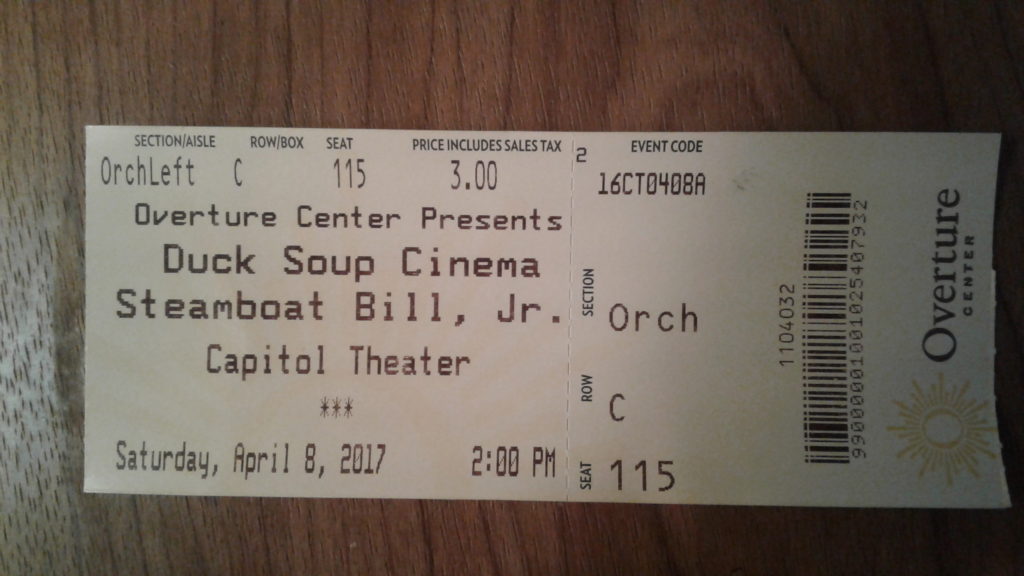On Madison, Wisconsin And Overture Center’s Premier Silent Movie Series
This article is a follow-up to last April’s showing of Madison, Wisconsin’s Overture Center for the Arts and the Capitol Theater’s Duck Soup Cinema series, which celebrated the end of its 30th season with Buster Keaton in Steamboat Bill, Jr., a film released the same year the Capitol Theater first opened in 1928. Preceded by vaudeville shows and featuring live organ accompaniment, Duck Soup is one of the longest-running and most successful silent movie programs in the country. I recently had the opportunity to talk to the series’ programmer, Overture Center’s vice-president of operations Rudy Lienau, and the series’ promotional liaison, communications manager Sarah Knab, about the past, present, and future of Duck Soup Cinema.
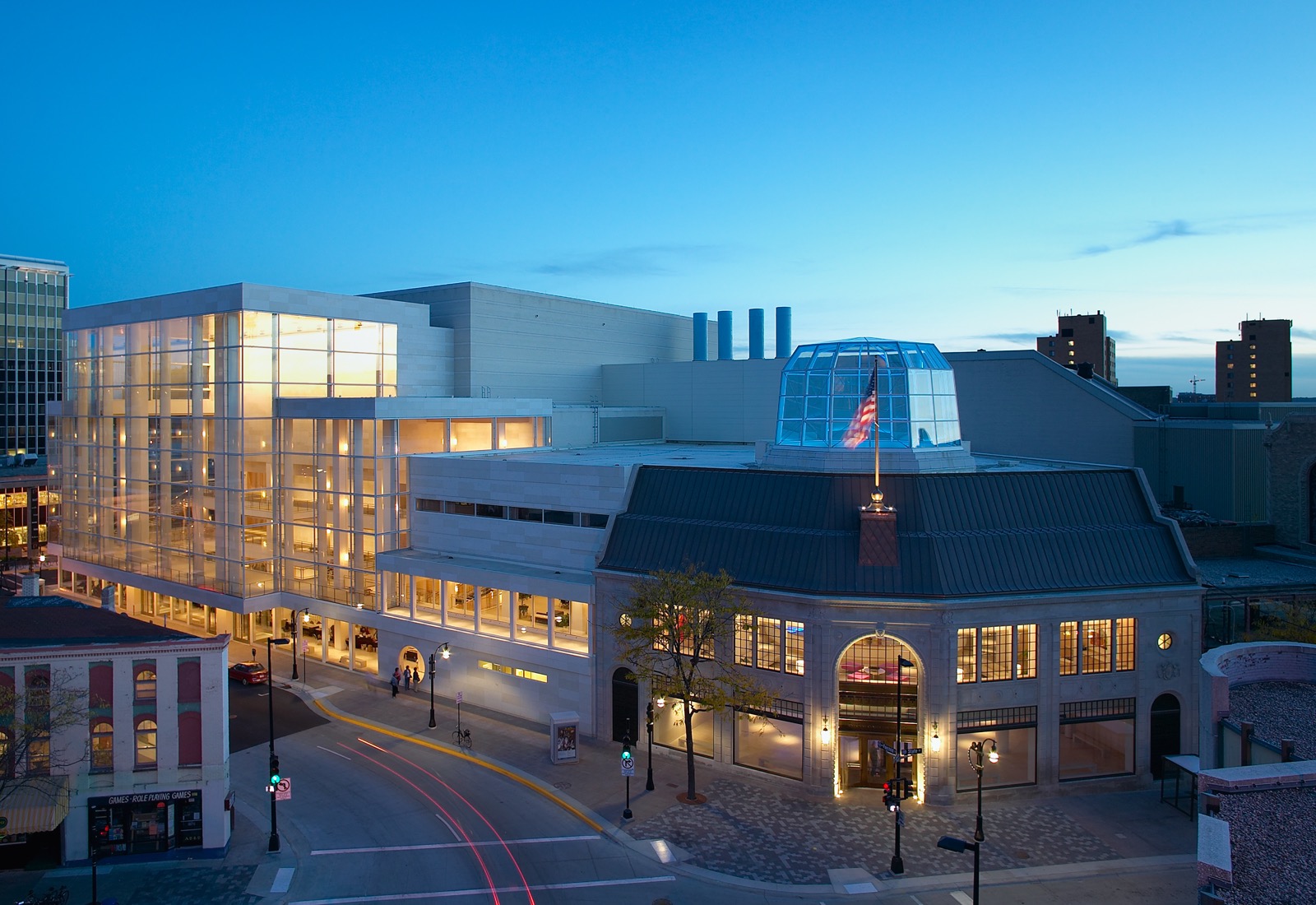
Overture Center for the Arts
Off the corner of State Street and N. Fairchild, one block away from the state’s capitol building, a multi-story glass and dome-topped edifice stretches in three sections alongside the city’s bustling downtown area.
Adorned with performance schedules and theater bills around its city block-long exterior, Madison, Wisconsin’s Overture Center for the Arts houses seven performance spaces, including four theaters; three art galleries off its main Rotunda; the Playhouse Gallery, extending from the Henry Street entrance to the Playhouse Theater; and finally, wrapping around the 3rd floor of the Rotunda, the James Watrous Gallery, affiliated with UW-Madison’s College of Letters and Sciences. Among the key performance spaces within the impressive structure, and a main venue within Overture Center since its re-dedication in 2006, is Madison’s historic Capitol Theater.
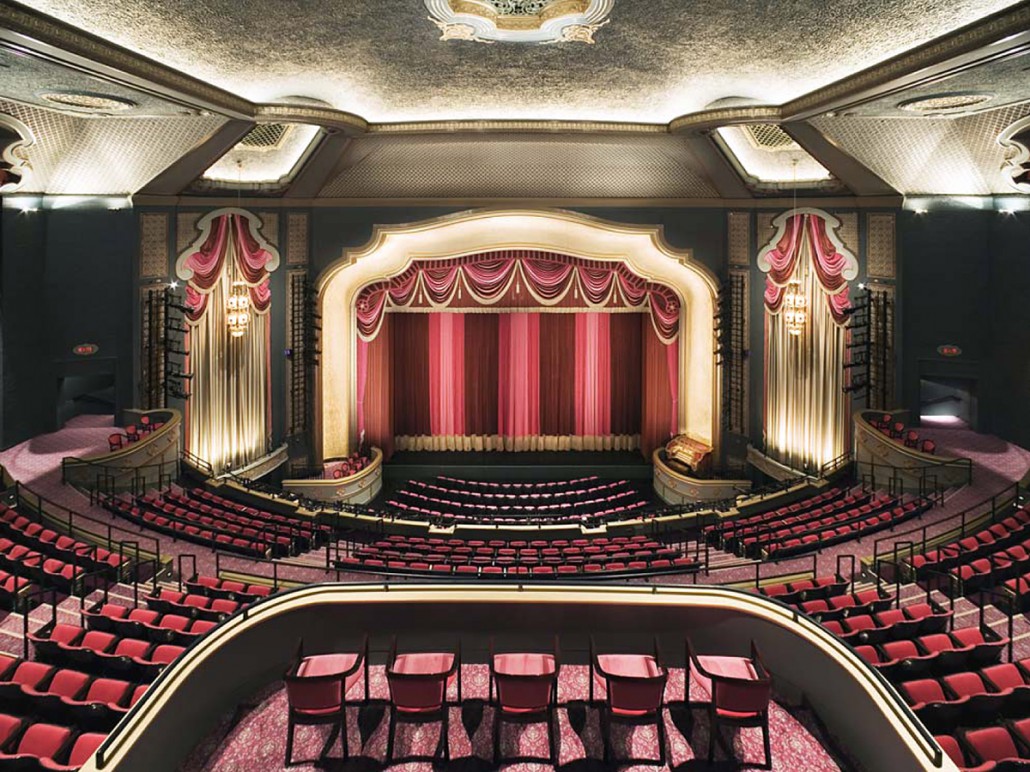
Capitol Theater interior
Opening its doors in October of 1928, the Capitol Theater was originally designed for one purpose: to show silent movies. With its magnificent Grand Barton Organ, one of the only of its kind still in its original installation, and whose pipe-rounded melodies greeted its first audience when the theater debuted, the Capitol continued as a mainstay of downtown Madison even as the era of silent movies ended. Revitalized as a performance stage and concert hall in the 1970s, the theater and its organ nonetheless remained a vital memory for Madisonians who recalled the days when “the raucous sounds of silents” thundered through its pitch-perfect, acoustic space.
History of the Series
As with many such beginnings, Duck Soup Cinema was inspired, according to Rudy Lienau, who conceived of the program and has organized every season since, by an advantageous convergence of pragmatic circumstances. First of all, there was the venue itself. Then known, since 1980, as the Oscar Mayer Theater, and the featured stage of the just-opened Madison Civic Center, the Grand Barton Organ had sat as mostly unused potential within the theater for decades. Older residents, many of whom had either attended or worked at the Capitol Theater during its heyday, began reminiscing about the Saturday matinees in which silent “stars” shone up on the big screen and the the theater’s own “star” – the Grand Barton itself – brought them to sonic life.
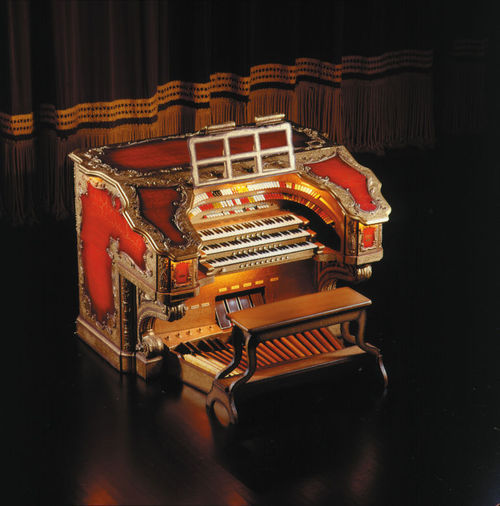
Grand Barton Organ
Lienau listened to these stories and began wondering if there was an audience in Madison for silent movies. At that time, the UW-Madison was planning its own one-off silent movie program and needed a theater space that could believably revive the spirit of moviegoing 50 years before. Through the UW, Lienau came in contact with School of Music instructor John Wright Harvey, an excellent keyboardist and carillon specialist, who in turn put him in contact with who was then possibly the country’s foremost authority on live organ silent movie accompaniment: Gaylord Carter.
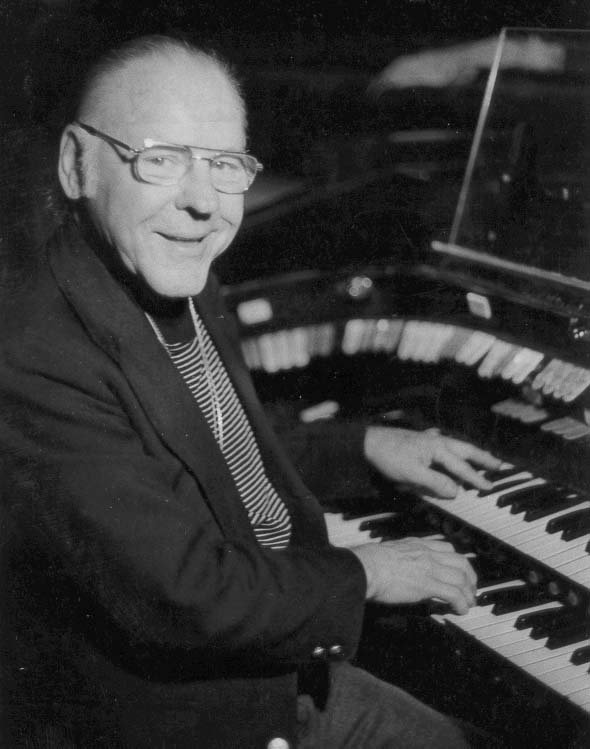
organist Gaylord Carter
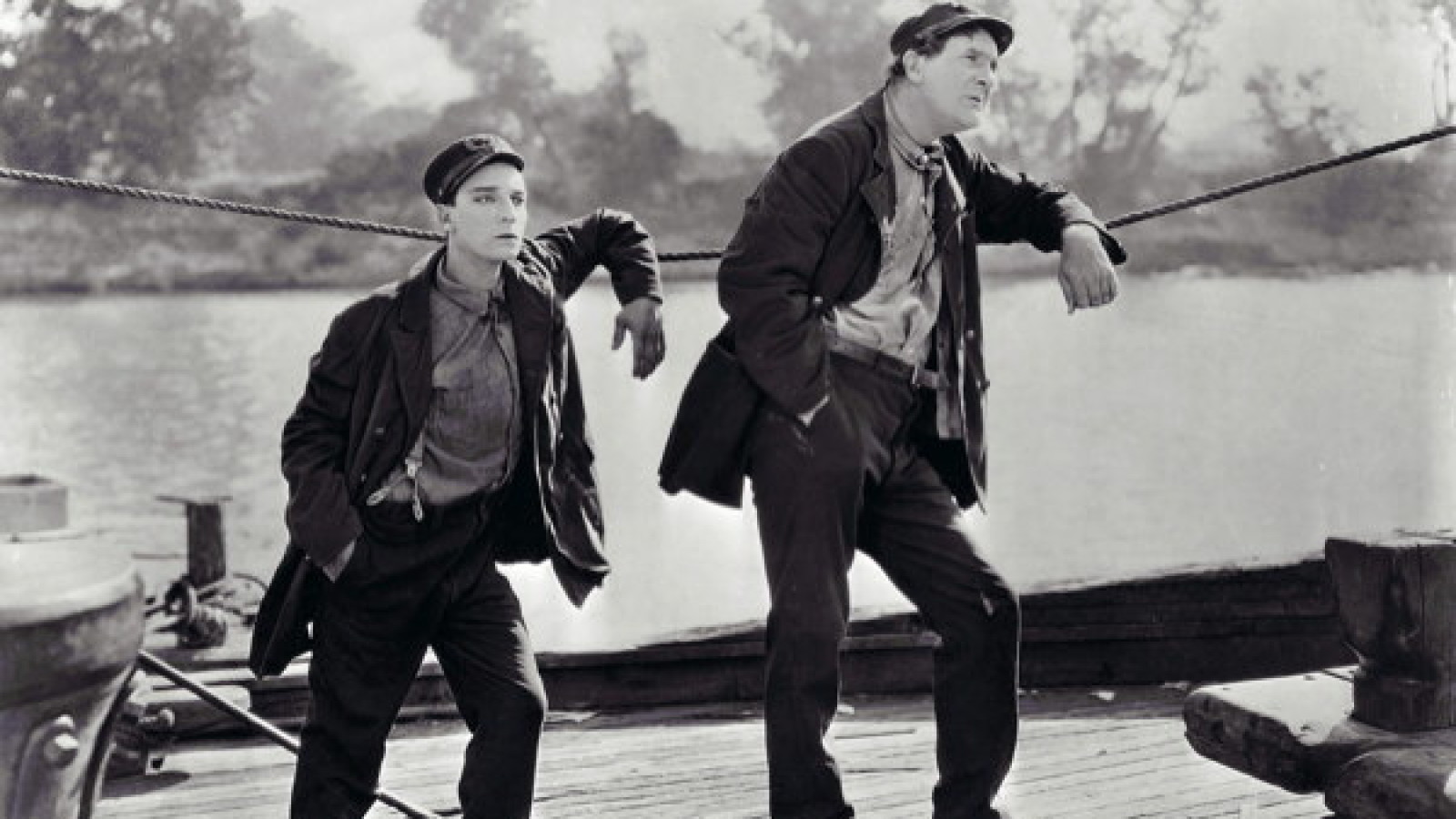
Buster Keaton (left) and Ernest Torrence (right) in STEAMBOAT BILL, JR. (1928)
Spending countless hours talking with Carter about the theater experience of the silent movie era, Lienau gleaned invaluable technical details – everything from the lighting to the proscenium “arch” framing the stage and screen – and received advice on and answers to numerous questions regarding performance and presentation. The weekend program of three silent films presented in October of 1983 included Rudolf Valentino in The Son of the Sheik (1926), Douglas Fairbanks in The Thief of Baghdad (’24), and Buster Keaton in Steamboat Bill, Jr. (’28); ALL accompanied by Carter on the Grand Barton. With little in the way of promotion beyond word of mouth, the event drew over 1,500 people within the 2-day period.
Three years later the inaugural event grew into the Civic Center and Oscar Mayer Theater’s “Sounds of Silents” series, which ran from 1986 to 1998. Presenting 2 – 6 silent movies per year, the “sounds” of the silent movie era were accompanied on the grand instrument by a revolving roster of theater organ masters including Carter; Carter’s protege Christian Elliott; local organist, and son of a long-time UW music professor, R. Cameron Monschein; noted preservationist Dennis James; and many distinguished others. Since 1998, the series has grown to include vintage-style performances preceding the movie – from jugglers and acrobats to choral groups and string bands – and was re-named “Duck Soup Cinema” in honor of the greatest vaudeville act in American history, the Marx Brothers.
In the years since the venue has reclaimed its original name of the Capitol Theater, attendance has also grown beyond the core of local silent movie fans – along with community sponsorship, door prizes, and general fun – to include children and their parents who thrill to the sights, sounds, and performance styles of yesteryear.
Presentation, Organ, and Vaudeville Show
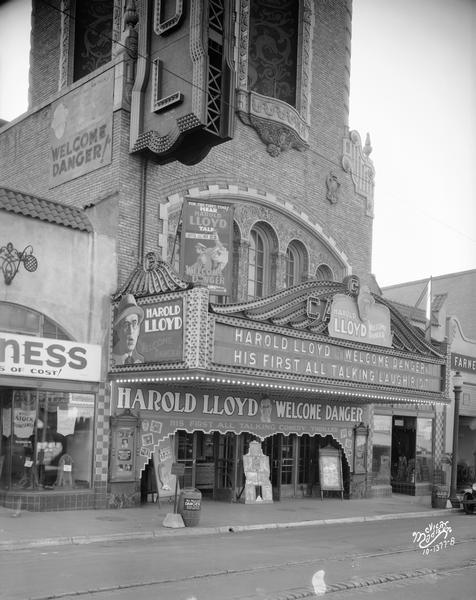
Capitol Theater exterior, advertising Harold Lloyd’s 1930 “first all talking all laughing picture” WELCOME DANGER!
What makes Duck Soup Cinema different from other silent movie presentations is the program’s commitment to turning back time for the space of about 3 hours to “the way it was.” Exhibiting the best source material available, the shape, size, and dimensions of the projected screen – right down to the colored lighting and shining “dot” which focuses a spectator’s visual attention – are all designed to be reminiscent of what an audience circa 1928 would have seen in similar silent movie theaters across the country. With two performances per day, usually at 2 pm and 7 pm on a Saturday, commencing with 1 – 2 showings in the fall and concluding with 1 – 3 showings in the spring, that commitment extends to both before and after each Duck Soup Cinema show.
A typical show begins with kids and their parents streaming into the ornate Capitol Theater lobby space, which with its bright crimson design, patterned carpeting, gilt-edge mirrors, plush furniture, and old photographs hanging on the wall – many of them of the Capitol Theater and downtown Madison during the late 1920s – closely resembles the sort of “passageway” that ushered in theater-goers 90 years before. As each audience member is issued a raffle ticket, for a mid-show door prize-drawing, a pair of balloonists and magicians – blowing up tube-like animals to all shapes and specifications or performing card and coin tricks – delight and entertain kids while their parents hustle off to a nearby stand for refreshments.
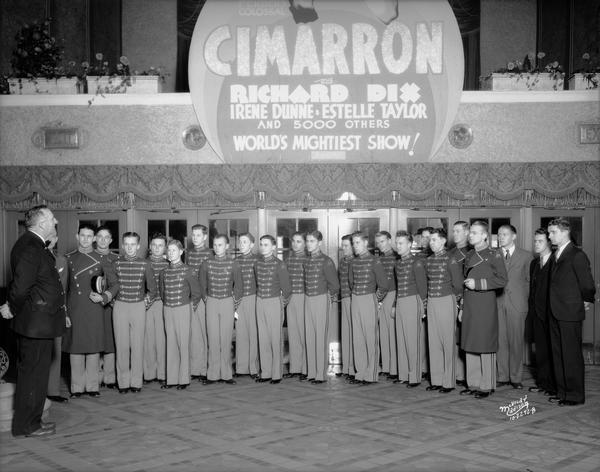
theater ushers at Madison’s Capitol Theater, 1931
Entering the two-tiered spectator space of the Capitol Theater, fanning above and below from the center stage to both floor and balcony seats, audience members with particularly good timing will be greeted simultaneously by the opulent mid-00’s re-design of the theater interior, restoring the cozy intimacy and the grand stateliness of the original venue, and the dulcet tones of the theater’s Grand Barton Organ. Perched to the right and above the stage in this electrically-illuminated musical pulpit, enthusiastically playing a period tune like “I’m Just Wild About Harry” or the always-appropriate “Hooray for Hollywood!”, have in recent years alternated between organists Clark Wilson and Jelani Eddington.
Tasked with setting just the right tone, quite literally, for the show and feature to follow, the art of live organ silent movie accompaniment lies in both evoking and tirelessly sustaining a proper musical mood. With the aid of cue sheets, and drawing from old-time tunes, musical motifs, and a prodigious physical memory of multitudinous themes and anthems, a silent movie accompanist not only relies on his or her intangible ability to musically describe, amplify, and underline the action or emotion contained in a scene, but also to gauge the audience’s own minute-by-minute and even second-by-second reactions through the organist’s much-taxed improvisatory skills. As such, the Grand Barton’s fourth-register “toy counter” – with its ability to mimic real-life sound-effects ranging from a shrieking train whistle to a neighing horse – gets quite the percussive workout during Duck Soup’s earlier matinee performance, when there are of course many more children present.
As the lights focus on the stage, MC Joe Thompson, with his trademark tuxedo, tails, and tennis shoes – along with his entertainingly groan-inducing puns, light-bulb jokes, and Cubs-fan baseball boosting – sets a fun, corny tone also uniquely his own. On stands to the right and left of the stage, in the style of silent movie titles, are cue cards that announce the show’s consistent local sponsor through the years, Goodman’s Jewelers – who also invariably supplies part of the gift packages drawn for the ticket raffle mid-show – and, preceding each of their appearances on-stage, the titles or names of the individual acts who will soon grace the stage in vaudeville-style succession before the main feature.
While in recent seasons Duck Soup has increasingly drawn on Overture Center’s Rising Stars program, a performance-based “talent show” that discovers local acts in Madison and surrounding Dane County, the principle remains the same since the performance aspect was added to the silent movie series: Could the act have conceivably been performed with a similar impact in the early 1900’s?
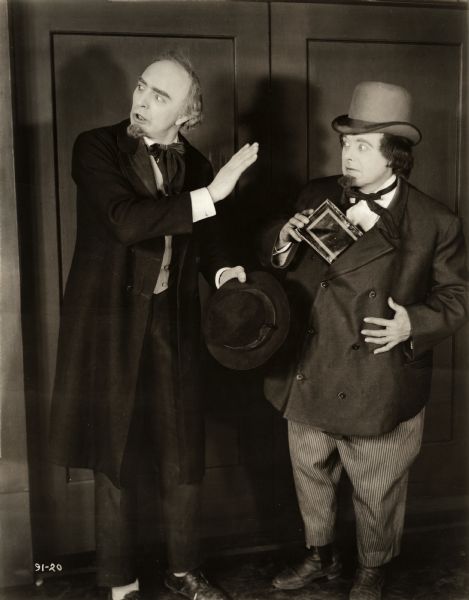
vaudeville performers Clarence Kolb (right) and Max Dill (left) in a still from the 1917 silent comedy BELOVED ROGUES
Plucking just one example from the numerous vaudeville performances I have seen at Duck Soup Cinema, this past April’s show featured a group of local high-schoolers performing fast-paced, Broadway-style numbers – but with clogging. A form of tap-dancing with metal “clogs” loosely-attached to the heel or toe of a shoe, “clogging” is a dance style confined in my previous experience to older, folk-type polka fairs and regional performances. To see the dance applied to a youthful and highly-energetic act before an awestruck audience was, for me, both unusual and refreshingly bracing; perhaps even recreating a now long-distant time in Wisconsin history when “cloggers” commanded the height of pop cultural impact for local yet time-remote audiences.
The novelty appeal of live vaudeville performance, then, precisely in keeping with this early twentieth century style of performance, is “entertainment, pure and simple.” With typically 8 minutes given to each of three separate acts, with a 3-minute break between each act, the half-hour, pre-feature show has in the past also featured whirlwind comedy, juggling, magic, and musical acts that together can make just the right impression of child-like wonder before the lights dim, the organ roars up, and the silent feature begins.
Silent Cinema and Silent Film Programming
Also adding just the right touch, organist Clark Wilson usually begins his Grand Barton performances of the silent movie with an invocation that completes the spell of turning the clock back 90 years or more: “Sit back and enjoy the perfumed twilight of this magnificent old electric pleasure dome.” Echoing the philosophical stance if not quite the poetic reverie of that statement, when asked whether he has yet considered using digitally-transferred projection for Duck Soup Cinema, series organizer Rudy Lienau candidly responded, “Not while I’m programmer.”
When Lienau first conceived of the series in the mid-1980s, and was then searching for appropriate exhibition material, he was often discouraged by the low quality “scratchiness” of commercial prints available. As the entire idea behind the series, again, is to in effect recreate the magical atmosphere found in that “perfumed twilight” of old, Lienau consulted numerous silent movie exhibitors and academics across the country and soon discovered that the more desirable and pristine film prints of silent classics, ranging from the perennial Halloween favorite of Lon Chaney in The Phantom of the Opera (1925) to the great silent comedies of Buster Keaton, are the sole province of dedicated film restorers, collectors, and preservationists. Since its first season 30 years ago to last year’s program of five highly varied films, which included two special showings of Fritz Lang’s Metropolis (1927) and an anniversary reprise of Douglas Fairbanks in The Thief of Baghdad, Duck Soup Cinema has predominantly relied on 35mm film prints that best preserve the unmistakable image quality, color screen-tinting, and often hand-drawn and lettered intertitles of 19-teens and ’20s cinema.

spectacular amber-tinted image from Fritz Lang’s METROPOLIS (1927)
Growing up, Lienau was first exposed to silent cinema courtesy of WGN and Frazier Thomas’ Midwest-syndicated children’s TV program, which included the slapstick comedies of Fatty Arbuckle, Mack Sennett’s Keystone Kops, Laurel and Hardy, and of course Charlie Chaplin and Buster Keaton – all narrated by host Thomas himself – as entertaining interludes to the puppet play and musical stylings of the popular show. Those memories undoubtedly infused Duck Soup’s reliance on the “Big 3” of silent comedy – Charlie Chaplin, Buster Keaton, and Harold Lloyd – and also happen to be the biggest live theatrical draws for silent movie fans. But, as Lienau is quick to note, some of the series’ biggest successes have occurred when having strayed from “the standards” to “more adventurous” silent movie fare.
Taking one further example from its 30th anniversary season, a programming “coup” of sorts was accomplished this past fall when Duck Soup Cinema showed a late 1927 romantic comedy titled Her Wild Oat, starring winsome silent screen idol Colleen Moore. Once again demonstrating the advantage of converging and practical circumstances, an archivist at the Wisconsin Center for Film and Theater Research, one of the country’s foremost libraries on film and Hollywood history, uncovered an over 85-year-old playbill advertising the opening of Madison’s Capitol Theater and its first-ever show.

Colleen Moore in HER WILD OAT (1927), the first film to be shown at Madison’s Capitol Theatre in 1928; part of this past year’s Duck Soup Cinema series
As luck would have it, this very film had recently been restored by UCLA and the Academy Film Archives and had been successfully received at film festivals and special showings both nationally and internationally. In addition, WCFTR had also recently restored a lively 16mm “home movie”, shot on the UW-Madison campus in the early 1920’s by a self-described “film fraternity”, to act as a fitting movie preamble to the Jazz Age comedy of manners receiving its second exhibition, at this very same venue, precisely 88 years after its first. Duck Soup Cinema’s 30th anniversary showing of Her Wild Oat, given an appropriately jazzy thrust by organist Jelani Eddington, was just about the closest this film fan has ever experienced to virtually stepping into a cinematic time machine.
Marketing and Promotion
Possibly the best draw for the series, in terms of attendance and family-friendly appeal, has been its broad-based accessibility. The special quality of silent movies, as an art form distinct from the later addition of sound, is in its transparency and simplicity of expression; so much so that a film made in 1919 has a better chance of being understood by a diverse audience than a film made even 10 or 20 years later. Despite an individual’s age, background, or country of origin, every movement made on-screen in a silent film derives instant recognition from audience members when performed by brilliant actors and pantomimists like Charlie Chaplin or Lillian Gish.

the exquisitely suffering Lillian Gish in D.W. Griffith’s grand melodrama WAY DOWN EAST (1920)
Because of course “silence” transcends language barriers; even, one could argue, when the intricately-designed intertitles appear as so many impenetrable blocks of text. Having taken my preteen nephews, now 7 and 9-years-old, to past showings of Buster Keaton and Harold Lloyd at Duck Soup has been an entertaining education in nascent film-viewing for me because there has been, without fail, that inexplicable movie magic moment where a gesture or action on-screen “hits” and these two kids of the 21st century are suddenly at the comic mercy of screen luminaries born in the 19th century.
When, for instance, the 7- (then 6-)year old saw his first silent movie Seven Chances (1925), he didn’t quite know what to make of the black-and-white pictures or the old style of clothes and cars, but when he saw Joseph Frank Keaton, Jr. pulling one of his immortal “Busters” – tumbling head-over-heels down a veritable mountain while hotly pursued by a spectacular avalanche of boulders-and-brides – the initially skeptical lad let out an actual and involuntary “Whoop!”
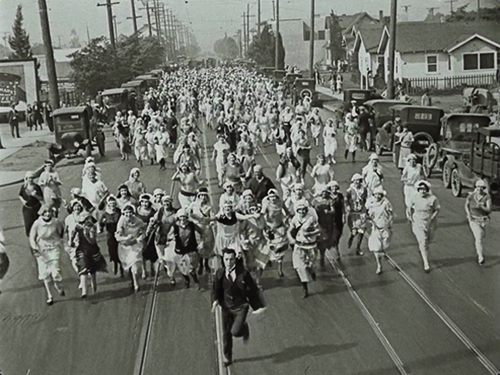
Buster Keaton, pursued, in 1925’s SEVEN CHANCES
Word of mouth, along with low- and special-ticket cost, then, has been the silent movie series’ best selling points towards attracting “audiences of all ages”. With community donations and subsidies from local businesses, along with generous individual contributions from series sponsors, Duck Soup Cinema, in its 31st season, beginning in the fall of 2017 and concluding in the spring of 2018, will continue to charge $7 for general admission and $3 for children 12 and under.
Along with three showings of more “accessible” fare, starting on October 7th, 2017 with Harold Lloyd in the film for which he is best known, The Freshman (1925), and ending with Buster Keaton on April 7th, 2018 in the film for which he is best known, Sherlock Jr. (1924) – with iconic flapper comedienne Clara Bow starring in 1926’s Mantrap on February 17, 2018 – these matinee-friendly showings will be alternated, as with last year’s “Special Feature” showings of Metropolis and The Thief of Baghdad, with 1926’s independent African-American WWI drama The Flying Ace on November 7th, 2017 and all-time film masterpiece Sunrise (1927) on March 17, 2018. Partly to encourage a broader, more specifically adult audience, both of these latter features will include only evening performances, priced at $10 per ticket, and, partly to discourage children attendance, will not be opened by vaudeville acts; but the Grand Barton Organ will continue to provide the silent films’ accompaniment for all showings.
Future of the Series
Indeed, much of the series’ future is tied with the venue’s most valuable fixture. Organ technician Glenn Tallar is now hard at work on a longer-term project of changing the Capitol Theater’s Grand Barton back to “the way it was”. Utilizing wood, glue, felt, and hand tools, the minute inner workings of the Grand Barton’s gradual return to its 1928 installation specifications, as described by Lienau and program coordinator Sarah Knab, sounds very much the sort of DIY affair firmly in keeping with Duck Soup’s philosophical initiative. Well-researched, consistent, and most of all true-to-form, the theater, performance, source material, and now finally its grand electrical instrument – a monument to early twentieth century ingenuity and technical know-how – will hopefully continue in future seasons of Duck Soup Cinema to create a unique, quality theatrical experience.
Characterized as a “public service” by the series’ dedicated programmer, after 32 years Rudy Lienau will be stepping down from his position as vice-president of Overture Center operations at the end of this month, but happily will be continuing as the productive force behind Duck Soup Cinema in his retirement. And Lienau has nothing if not a well-spring of ideas for possibly bringing other film-based ventures to the now-predominantly theater and performance-based Overture Center: including top-flight presentations of AFI Top 100 film classics from Hollywood’s Golden Age, a program of early sound-on-disc Vitagraph films, and even an exciting venture into the modern era of special effects with one of the producers from the 2002 film version of The Time Machine.
The most frequent feedback Duck Soup Cinema receives from its numerous visiting technicians, performers, and academics is that the series “does silent movies right”. If nothing else is to be taken away from an afternoon or evening of riotously infectious music, performance, and film, it’s that Madison, Wisconsin is very fortunate indeed, especially for a community its size, to have a low-cost, all-ages silent film series that is artistically, culturally, and historically true to its venue, its instrument, and most of all to the rich era of cinema it’s representing. And all the more amazing for having continued to draw such keen community interest after an astonishing 30 seasons.
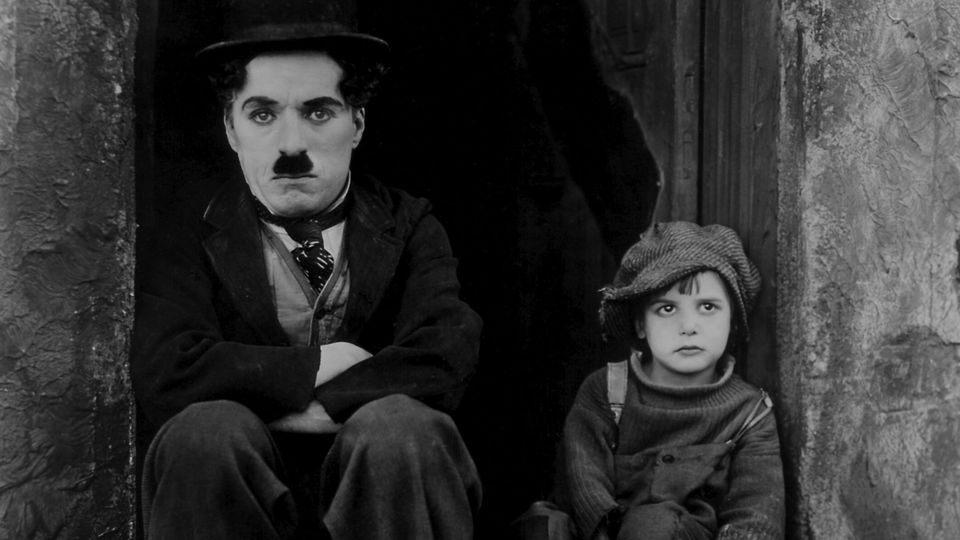
Charlie Chaplin (left) and Jackie Coogan (right) in Sir Charles Spencer Chaplin’s monumental silent comedy, THE KID (1921)
When asked to describe his “dream event” for Duck Soup Cinema, Rudy Lienau concluded our chat by waxing fondly on the post-1921 features of Charlie Chaplin. In 1921, Chaplin released the first truly cohesive and full-length narrative comedy film, The Kid – described in its original vintage advertising as “6 Reels of Joy” – and ushered in an era where gags were enriched on movie screens by an involving story and sympathetic characters. One of the film’s most affecting scenes occurs in the Little Tramp’s impoverished garret where the title kid, played by 6-year-old Jackie Coogan, is forcibly taken from his adoptive father by a visiting doctor, policeman, and driver cruelly representing the County Orphan Asylum. Alternating between a savage and tender mix of comedy and pathos, the sequence balances the realistic terror of the situation – the expressions of anguish on Chaplin’s and Coogan’s faces undimmed across 96 years – with an exuberant chase over rooftops, down streets, and finally into the flatbed of a speeding van as the Little Tramp triumphantly rescues The Kid.
Bringing comic light to the often grim realities of yesteryear, along with the fast visual pacing augmented by proper musical setting, the sequence is but one moment of our vast cultural heritage that deserves the appreciation of a sympathetic audience. Fortunately, the joys and tears, the beauty and pulse-pounding emotion of a century before are revived 3 – 5 showings annually for Madison, Wisconsin and Overture Center for the Arts‘ premier silent movie series.
My special thanks, again, to Rudy Lienau and Sarah Knab of Overture Center for the Arts for graciously setting aside time to talk to me and for their further generous assistance in preparing this article. All photographs and images in this article are used as specific reference to either the time period represented or the historical personalities mentioned.
